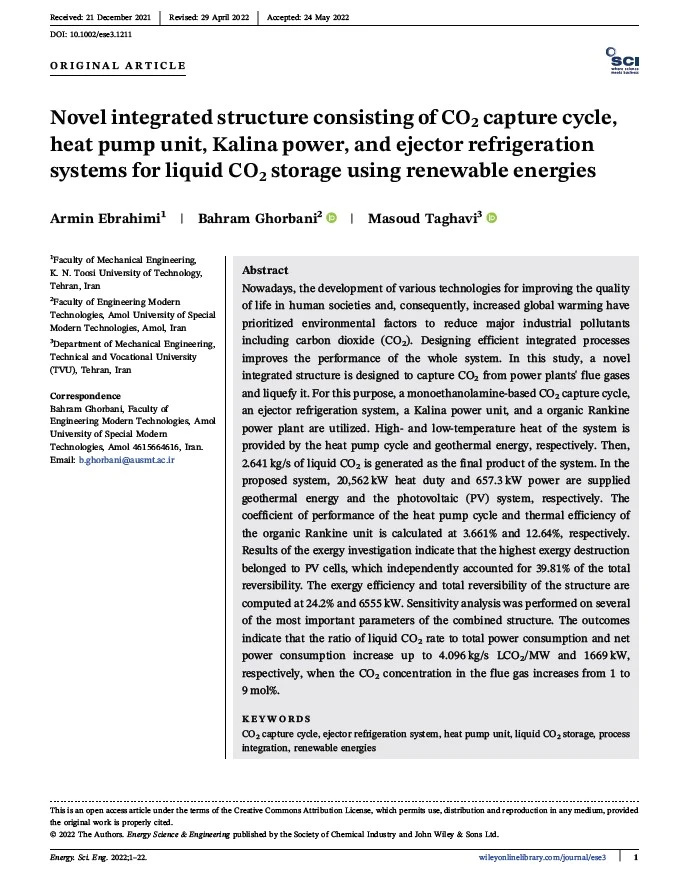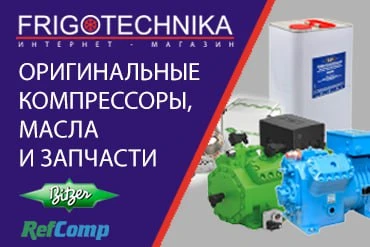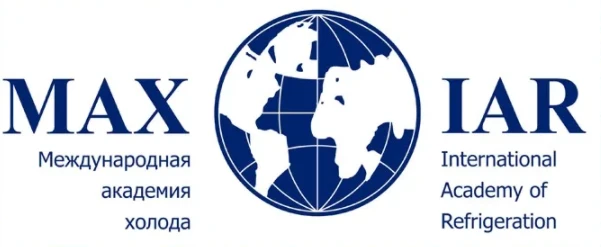Автор: Armin Ebrahimi, Bahram Ghorbani, Masoud Taghavi
Год: 2022Язык: АнглийскийТип: Статьи
Nowadays, the development of various technologies for improving the quality of life in human societies and, consequently, increased global warming have
prioritized environmental factors to reduce major industrial pollutants including carbon dioxide (CO2). Designing efficient integrated processes improves the performance of the whole system. In this study, a novel integrated structure is designed to capture CO2 from power plants' flue gases and liquefy it. For this purpose, a monoethanolamine‐based CO2 capture cycle, an ejector refrigeration system, a Kalina power unit, and a organic Rankine power plant are utilized. High‐ and low‐temperature heat of the system is provided by the heat pump cycle and geothermal energy, respectively. Then, 2.641 kg/s of liquid CO2 is generated as the final product of the system. In the proposed system, 20,562 kW heat duty and 657.3 kW power are supplied geothermal energy and the photovoltaic (PV) system, respectively. The coefficient of performance of the heat pump cycle and thermal efficiency of the organic Rankine unit is calculated at 3.661% and 12.64%, respectively. Results of the exergy investigation indicate that the highest exergy destruction belonged to PV cells, which independently accounted for 39.81% of the total reversibility. The exergy efficiency and total reversibility of the structure are computed at 24.2% and 6555 kW. Sensitivity analysis was performed on several of the most important parameters of the combined structure. The outcomes indicate that the ratio of liquid CO2 rate to total power consumption and net power consumption increase up to 4.096 kg/s LCO2/MW and 1669 kW, respectively, when the CO2 concentration in the flue gas increases from 1 to 9 mol%.
prioritized environmental factors to reduce major industrial pollutants including carbon dioxide (CO2). Designing efficient integrated processes improves the performance of the whole system. In this study, a novel integrated structure is designed to capture CO2 from power plants' flue gases and liquefy it. For this purpose, a monoethanolamine‐based CO2 capture cycle, an ejector refrigeration system, a Kalina power unit, and a organic Rankine power plant are utilized. High‐ and low‐temperature heat of the system is provided by the heat pump cycle and geothermal energy, respectively. Then, 2.641 kg/s of liquid CO2 is generated as the final product of the system. In the proposed system, 20,562 kW heat duty and 657.3 kW power are supplied geothermal energy and the photovoltaic (PV) system, respectively. The coefficient of performance of the heat pump cycle and thermal efficiency of the organic Rankine unit is calculated at 3.661% and 12.64%, respectively. Results of the exergy investigation indicate that the highest exergy destruction belonged to PV cells, which independently accounted for 39.81% of the total reversibility. The exergy efficiency and total reversibility of the structure are computed at 24.2% and 6555 kW. Sensitivity analysis was performed on several of the most important parameters of the combined structure. The outcomes indicate that the ratio of liquid CO2 rate to total power consumption and net power consumption increase up to 4.096 kg/s LCO2/MW and 1669 kW, respectively, when the CO2 concentration in the flue gas increases from 1 to 9 mol%.
















Комментарии
Войдите или зарегистрируйтесь, чтобы оставить комментарий